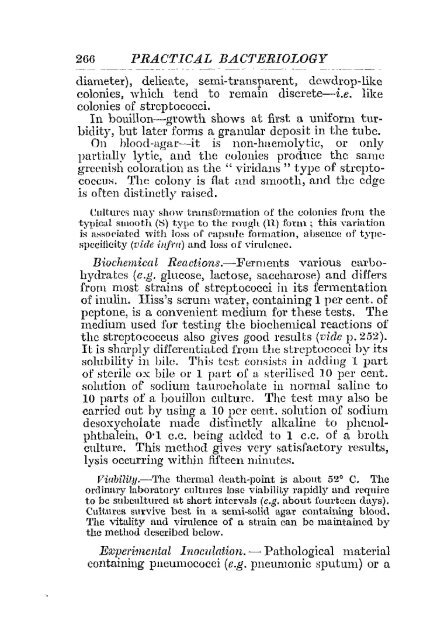AGf~ICULTURAL RESEARCH, PUSA.
AGf~ICULTURAL RESEARCH, PUSA.
AGf~ICULTURAL RESEARCH, PUSA.
You also want an ePaper? Increase the reach of your titles
YUMPU automatically turns print PDFs into web optimized ePapers that Google loves.
266 PRACTICAL BACTERIOLOGY<br />
diameter), delicate, semi-transparent, dewdrop-like<br />
colonies, which tend to remain discrete-i.e. like<br />
colonies of streptococci.<br />
In bouillon--growth shows at first a uniform turbidity,<br />
but later forms a granular deposit in the tube.<br />
On hlood-agar-it is non-haemolytie, or only<br />
partially lytlc, and the colonies procluce the same<br />
greenish coloration as the" viridans " type of streptococcus.<br />
'I'he colony is flat and smooth, and thc cdge<br />
is often distinctly raised.<br />
Cultures may show transformation of the colonies from the<br />
typical stll()oth (t:i) type to the rmtgh (It) form; thifi variation<br />
is nsso('iated with loss 01' ('apsu[c formation, absence of typespecificity<br />
(vide infrll) and loss of virulence.<br />
Bioche;wical Reactions.-Ferl1lents various Cal'hohydrates<br />
(e.g. glucose, lactose, saccharose) and differs<br />
from most strains of streptococci in its fermentation<br />
of inulin. Hiss's scrum water, containing 1 pcr cent. of<br />
peptone, is a convenient medium for these tests. The<br />
medium used for testing the biochemical reactions of<br />
the streptococcus also gives good results (vide p. 252).<br />
It is sharply differentiated from the streptococci by its<br />
solubility in bile. This test c:omists in ac1dillg 1 part<br />
of sterile ox bile or 1 part of a sterilised 10 per cent.<br />
solution of sodium taurocholate in normal saline to<br />
10 parts of a bouillon culture. The test may also be<br />
carried out by using a 10 per cent. solution of sodium<br />
desoxycholate made distinctly alkaline to phenolphthalein,<br />
0'1. e.c. being addcd to 1 c.C. of a broth<br />
culture. This method gives very satisfactory results,<br />
lysis occurring within fifteen minutes.<br />
ViuVllity.-'l'he thermal death-point is al)out 52° C. The<br />
ordinary laboratory cultures lose viability rapidly and require<br />
to he subcultured nt short intervals (e.g. about fUUl·tecn days).<br />
Cultures survive best in a semi-solid agar containing blood.<br />
'l'he vitality and virulence of a strain can be maintained by<br />
the method described below.<br />
Expcl'itnental Inoculation. - Pathological material<br />
containing pneumococci (e.g. pneulllonic sputum) or a

















